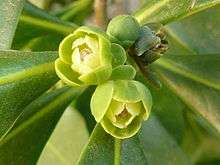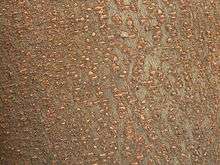Warburgia salutaris
Warburgia salutaris (pepper-bark tree, Afrikaans: Peperbasboom, Sotho: Molaka, Venda: Mulanga, Zulu: Isibaha)[1] is a species of tree in the family Canellaceae. It is found in eastern and southern African locations e.g. Botswana, Namibia, Tanzania, Zambia, Mozambique, South Africa, Eswatini, Malawi and Zimbabwe and Kenya. It is threatened by habitat loss. It is a popular medicinal plant and is overharvested in the wild, another reason for its endangerment.[2] The Pepper-bark tree is a protected tree in South Africa.[1] Various projects are investigating methods of propagation under controlled conditions with subsequent planting in the wild.[3]
| Warburgia salutaris | |
|---|---|
 | |
 | |
| Scientific classification | |
| Kingdom: | Plantae |
| Clade: | Tracheophytes |
| Clade: | Angiosperms |
| Clade: | Magnoliids |
| Order: | Canellales |
| Family: | Canellaceae |
| Genus: | Warburgia |
| Species: | W. salutaris |
| Binomial name | |
| Warburgia salutaris (Bertol.f.) Chiov. | |
This is an erect tree growing up to about ten metres in maximum height, but known to reach 20 metres at times. It has a thick canopy of aromatic, shiny green leaves. The evergreen leaf blades are lance-shaped, measuring up to 11 cm long by 3 wide. The flowers have ten yellow-green petals. They are each just under a centimeter long and are solitary or borne in small clusters of up to 3. The fruit is a berry, leathery purple or black in color when ripe, measuring up to 4 cm wide.
The leaves are used to add peppery flavoring to food and tea.[3] The bitter taste of the tree's bark and leaves is due to the presence of iridoids. The aromatic, oily, yellowish wood is used for firewood.[3]
Traditional medicine
This plant is used medicinally by the Maasai people to treat malaria.[4] It is used as a snuff or smoked for respiratory complaints such as common cold and cough.[3] The bark can be purchased at markets in Tanzania,[5] and elsewhere.[6]
References
- "Protected Trees" (PDF). Department of Water Affairs and Forestry, Republic of South Africa. 3 May 2013.
- "Warburgia salutaris | PlantZAfrica.com". www.plantzafrica.com. Retrieved 2017-07-18.
- W. salutaris. World Agroforestry.
- Bussmann, RW; Gilbreath, GG; Solio, J; Lutura, M; Lutuluo, R; Kunguru, K; Wood, N; Mathenge, SG (2006). "Plant use of the Maasai of Sekenani Valley, Maasai Mara, Kenya". Journal of Ethnobiology and Ethnomedicine. 2: 22. doi:10.1186/1746-4269-2-22. PMC 1475560. PMID 16674830.
- "Indigenous multipurpose trees of Tanzania: Uses and economic benefits for people - WARBURGIA SALUTARIS". www.fao.org. Retrieved 2017-07-18.
- Botha, J.; Witkowski, E.T.F.; Shackleton, C.M. (2004). "The impact of commercial harvesting on Warburgia salutaris ('pepper-bark tree') in Mpumalanga, South Africa". Biodiversity and Conservation. 13 (9): 1675. doi:10.1023/B:BIOC.0000029333.72945.b0..
